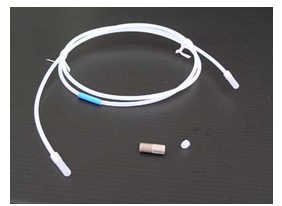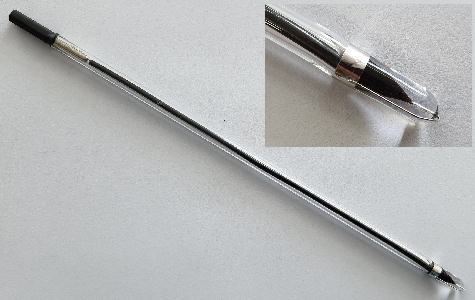Polygel Salt Bridge

Salt/Electrochemical bridges have long been used in corrosion testing. Labtec took a step further with their own design the Polygel Bridge.
Using glass tubing, agar gel, cotton wool plugs, filter paper and bits of string to form a salt bridge belongs in the past. The polygel bridge replaces all of these, and is more reliable and versatile.
The polygel bridge can be made between half-cells or to external reference electrodes. It is flexible and small diameter making it useful for work involving small volume cells, flow cells, etc. They can be made in any length but are best used as short as is practicable (less than 1m).
A teflon tube is used containing a saturated salt gel with a porous plug pressed into each end. The gel is not water soluble (unlike Agar) and the inert materials used enable the bridge to be used in most chemical environments. Temperature tolerance is continuous up to 100 degrees C and up to 120 degrees C for short periods. Bridges can be supplied containing either Sulphate, Chloride or Nitrate based gels and are supplied with silicone rubber end caps containing the same solution to prevent drying out.
Two diameters of bridge are available – 2.4mm and 3.2mm. and the thicker diameter tube can be supplied with Teflon or Polypropylene compression fittings.
Platinum band electrodes
The standard Platinum Electrode is a Platinum foil of approximately 2 sq.cm. bonded to a glass tube stem 250mm long x 7mm diameter. The top of the stem has a 4mm socket compatible with a 4mm lead plug.
The Platinum band electrode is more robust when compared to the typical flag style.
Ideal for use as an auxiliary or counter electrode.
Product code: ACM-Pt
Electrochemical laboratory test cells
An alternative, and cheaper version, to the standard, all glass, laboratory test cell featuring a polypropylene cell lid which can be drilled to customer’s specifications for the items they need to include in their test cell.
Based on the familiar 1 litre glass vessel with a 150mm ground glass flange, Labtec produced a plastic (Polypropylene, PVC, PTFE or PEEK) lid to replace the usual multi-necked glass lid. The benefit of this is that it enables ports (threaded, tapered or ‘O’ ring seal) to be machined into the lid. Unlike glass lids our plastic lids can be drilled/modified as necessary without the expense and limitations of glassblowing.
See ACM Instruments cell kits for examples of what is available.

